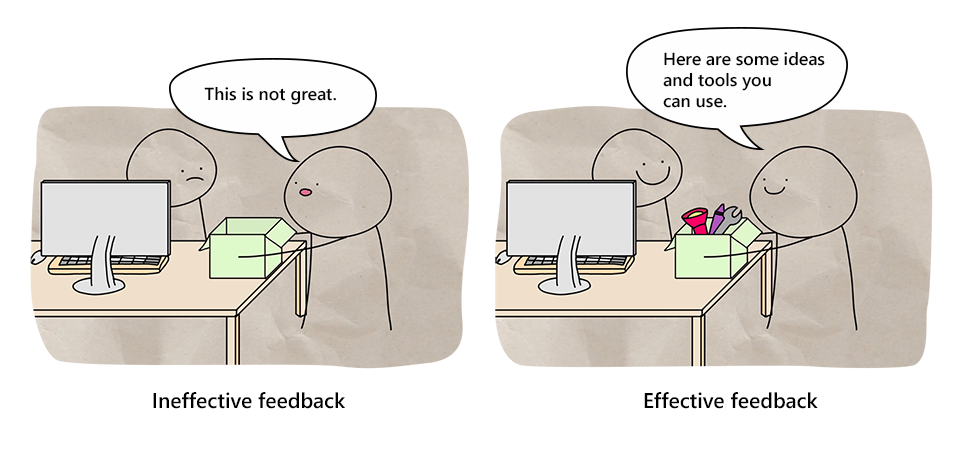Develop strategies for giving and receiving effective feedback
In our scenario, when you started giving your team feedback, you noticed that some people were more receptive than others. And you noticed that the more receptive people had a marked improvement in their coding skills. By contrast, some team members let you know that your feedback wasn't very useful, and they've been hesitant to submit their code for further reviews.
In this unit, you'll explore ways of providing and receiving feedback more effectively.
Deliver feedback respectfully
Feedback can sometimes be difficult to deliver. How you deliver feedback is a key factor in how it's received and implemented. You might be tempted to soften criticisms with positive words or praise, or to omit negative feedback altogether. Then again, you might feel that instead of underplaying the mistakes, you can benefit the person more by being blunt and honest.

By being specific and giving recipients concrete steps to try next, you pass on actionable goals while facilitating their path to success. You can implement the following strategies to exchange feedback in a constructive manner.
Learn by giving and receiving feedback
It's helpful to consider the role that feedback plays in someone's personal process. When you formulate your feedback in a wise manner, you include specific points that convey both your intention and your belief that the person can meet a high standard. By doing this, you can effectively facilitate someone's learning and help them move forward. Remember that feedback isn't given in a vacuum. Many factors can affect how the person might receive the feedback. Therefore, you must be intentional in gaining their trust and conveying that you want them to succeed.
Give feedback
Framing feedback appropriately is important if you want to create a culture of trust, belongingness, and sustained motivation. Sharing the purpose of the feedback along with your belief in the person's ability to persist, learn, and succeed is the first step.
When you provide feedback, you can:
- Ask others how they'd like to receive feedback: written, live, privately, or in a group.
- Reassure them that you have confidence in their ability to progress and improve their skills.
- Provide specific feedback on areas of improvement.
- Give directions and guidance on the next steps.
Setbacks are natural occurrences in the path of learning. To recover from a setback, people must accept and understand their areas of weakness and then apply corrective measures. The feedback you provide should give them the tools they need to bridge any skill or knowledge gaps.
Receive feedback
Just as you need to do a bit of digging to understand the root causes of error messages, you might need to unpack the feedback you receive from others to extract the underlying meaning.
Sometimes the feedback you get:
- Isn't packaged or worded in a way that helps you know how to act.
- Causes you to feel defensive or discouraged.
- Reinforces your feelings of not belonging.
When you receive feedback, you can:
- Ask for clarifying feedback when it isn't specific or clear enough for you.
- Seek another opinion or have someone help unpack the feedback with you.
- Reset expectations when it's clear that you took on a task or project that you no longer can commit to.

It's important to recognize that issues in your work aren't a reflection of your personal worth. So it's critical to ask clarifying questions that help you separate ideas (what you've created) from identity (who you are). Remember from the video, feedback might sometimes seem biased, unjustified, or excessively negative.
Negative feedback can sometimes just be a metaphorical box of thorns and “terrible in every way.” Apart from undermining your confidence, it might not provide any encouragement or helpful guidance on next steps for improvement. In such situations, the only option available to you is to move away from the feedback altogether.

Exchange feedback by using various methods
You can use several methods for exchanging feedback with other people. You could schedule a one-on-one meeting with them to give them verbal feedback. You could provide feedback to several individuals in a group setting.
You could also have an informal chat with the employee, mentee, or developer. For example, you could offer to sit with them and run their program together. Then you could go over the errors, explain the error messages, and do a step-by-step debug of the code to demonstrate how to resolve programming errors.
If you're in a situation where you need to send your feedback immediately and you can't meet with the developer in person, you could send your review by email. You then could follow up with either an in-person or virtual meeting, or even a phone call, to discuss the feedback and answer any questions.
Tips for leaders, mentors, and managers
You've seen how providing effective, wise feedback is an essential skill. You now want to improve such skills. Some tips that you can follow are:
- Ask whether this is a good time to meet. Recognize that untimely feedback might be neither welcome nor useful.
- Ask whether they prefer to receive feedback in a specific form. Some might prefer one-on-one "live" feedback, and others might find asynchronous written feedback preferable. For instance, a neurodiverse developer might want time to sit and process feedback on their own before discussing it with the reviewer.
- Ask whether they're open to other strategies.
- Remember to provide specifics. Feedback that's too vague is often unhelpful.
- Focus on how to change the process, not just what's wrong with the outcome.
- Be inclusive, positive, and constructive.
- Help the person reflect on the areas of improvement at an individual level.
- Act as a mirror to the person to give perspective on the experience.
- Remind them that they have the potential to continue, they do belong, and they can shape their future.
- Think about the other person's perspective by considering other factors that could affect their energy and engagement.
- Be courteous and kind. Remember to focus your review comments on the task or behavior and not the person.
- Explain your reasoning. This is especially important in code reviews when you provide feedback about logical or functional errors.
Wise feedback is the first step toward encouraging people to be open to your comments. Reinforce the high expectations that you have for them and emphasize your confidence that they can meet those high expectations.
